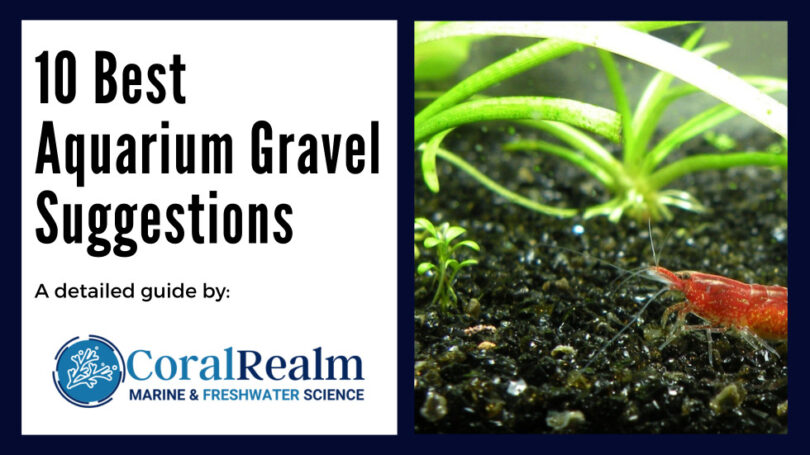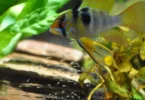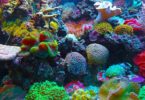Last Updated on April 21, 2023 by Jakob
There is no doubt that a carefully chosen gravel for the bottom of your aquarium can make all the difference to the appearance of your fish tank. Furthermore, appropriate gravel contributes to the health and longevity of the aquatic plants.
The choice of aquatic plants, ornaments and wood sculptures are all showcased on a bed of attractive and functional substrate or gravel.
An attractive gravel enhances the tank in terms of both appearance and environment for the plants and freshwater fish.
Gravel is therefore not just an attractive addition to the aquarium. It also provides an appropriate anchor and planting substrate for your aquatic plant selection, and gives us an opportunity to add solid fertilizer to the roots of the plants to enhance their growth and survival.
There is a broad selection of gravels and substrates on the market, with variety both in color, size and shape; all of which will change the appearance mood of your tank. In conjunction with your lighting choices, the varying gravels will alter the general ambiance of the aquarium.
Some aquarium owners will be looking for a gravel that makes a good backdrop for their fish – make the fish standout – whilst other people will be prioritizing the health and longevity of their aquatic plants. Many owners will be striving to achieve a balance between all of these issues.
This article aims to give you a comprehensive review of some of our top suggestions for the best aquarium gravel for your tank.
IN THIS ARTICLE
10 Best Aquarium Gravel Suggestions For Planted Tanks – Updated for 2023
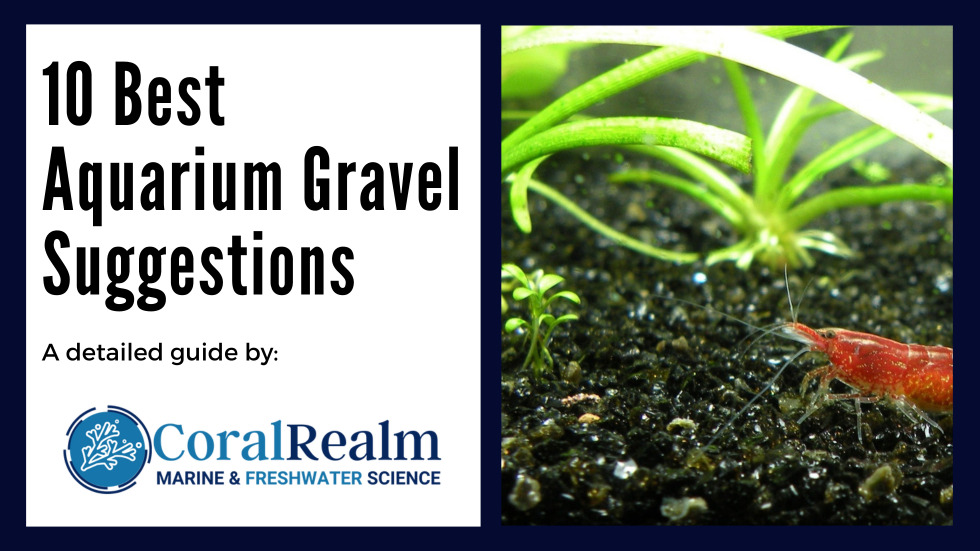
The table below gives a quick overview of our selection of colored gravels, with our more detailed reviews following later in the article. We don’t really recommend the fluorescent gravels that are available these days, because we have heard of some brands causing high levels of toxicity within the tanks resulting in actual fish death in some cases. If you really like the ‘glow in the dark’ or fluorescent options, please buy wisely and study the reviews from other purchasers first.
The Importance of Aquarium Gravel and Why You Should Use It
There are so many reasons why having the best aquarium gravel is an important addition or even a starting point in the creation of your tank environment.
Appearance and Atmosphere
Gravels and come in so many sizes and colors, that a carefully selected gravel can look really beautiful as the base layer within your aquarium.
Depending on your choice of planting and other rocks and ornaments within your tank, whether you decide on an authentic color as would be found in nature or plump for a more brightly colored, decorative substrate, the use of gravel will always enhance the overall atmosphere and appearance of your aquarium.
Functional Advantages
Apart from the purely aesthetic standpoint, gravel has a vital and important functional role within the tank.
First and foremost, it provides an appropriate medium into which you can introduce your aquarium plants. Aquatic plants will grow their roots through the gravel and anchor in.
The gravel will secure the plant in place preventing it from drifting loose before having the chance to establish its own root growth and therefore secure itself. A carefully chosen aquarium fertilizer can also be introduced within the gravel to again augment the establishment of the aquatic plants.
Gravel adds to the provision of a natural environment for your tank. Fish, particularly the bottom feeders, love to forage through the gravel in search of food.
What to Consider when Choosing Best Aquarium Gravel
There are so many substrate options. There are choices of sand and substrates for plants, fine coral sand for marine tanks, gravel choices include fine through to course, and many manufacturers make a variety of colors to create different moods and appearances.
We will focus in this article on freshwater aquarium options (needless to say that the fine coral sands are often a good choice for marine tanks with corals and salt water fish varieties).
When selecting a gravel, always ensure that there are no sharp stones or edges within the material. This can be harmful to fish and shrimps, especially bottom feeders such as Clown Loaches which enjoy foraging in the substrate, so care must be taken to avoid damage to their barbels which they use to sift through the substrate when looking for their food.
The courser gravels are more appropriate in tanks which are homes to larger fish species, for example Central and South American Cichlids. For these larger fish, the courser gravel would more closely emulate their natural environment.
The choice of substrates can also affect the water quality and chemistry/mineral balance and this needs to be taken into consideration.
For example, natural gravels can make the water somewhat harder, so the water in your area is soft the natural gravel can increase the pH balance of the water in your aquarium. Silica sand is a substrate that looks striking and does not create hardness to the water.
Generally speaking, for most freshwater aquariums gravel is a good choice of substrate material for many reasons.
From a purely aesthetic perspective, there are sizes and colors to create many different appearances.
Gravel does not have the same potential as sand to get into either fish tank canister, under-gravel, or HOB filters, causing damage and water quality issues. This is simply because gravel is heavier than sand and tends to remain on the floor of the aquarium.
Water can easily flow through a gravel substrate which again keeps the tank healthy and avoids build-up of bacteria on the tank floor trapped within the substrate.
However, sand substrate, given that it is very closely packed without the spaces between the gravel stones, doesn’t need to be changed as often as the detritus in the tank cannot penetrate down within the tightly packed sand.
So, as with all things, there are both pros and cons of all the different substrate and gravel options available, but you can’t go far wrong with gravel as a substrate as it represents a good and appropriate all-round choice for the freshwater aquarium.
Colored Best Aquarium Gravel
Keep in mind that gravel doesn’t only make your aquarium look good – it contributes greatly to the general health of the tank.
By providing a suitable environment for the roots of your aquatic plants, it enhances the growth and longevity of your planting and therefore helps to maintain and healthy tank.
Gravel also provides opportunities for fish to forage for food, especially bottom feeders such as Plecos, which gives them enrichment opportunities – important for any creature not kept in its natural habitat.
10 Best Aquarium Gravel Reviews
1) Carib Sea Gemstone Creek Aquarium Gravel
This gemstone gravel consists of varying shapes and colors that blend very well together creating a natural effect in the fish tank. This gravel will provide a good substrate for your aquatic plants and an anchor for any decorations or artificial plants that you choose for your fish tank.
As with all substrates, this gravel will need to be washed through several times before adding it to your aquarium as reviews show that it does not come pre-washed. So do take time out to wash the gravel portion by portion in a colander or other appropriate receptacle so that you don’t have your filter struggling with the debris.
2) Pure Water Pebbles Salt and Pepper Aquarium Gravel
This is a striking choice as a fish tank substrate. Black and White – looks stunning and effective, but is not too bright and distracting as some of the more unusual colors can be.
This is a premium freshwater substrate with a 100% acrylic coating which makes it totally color-fast, so you don’t need to worry about any color leaking into the water column and harming your fish.
As this is a non-toxic aquarium substrate, it will not alter the finely balanced chemistry of the water in your aquarium, and this is an important factor in the choice of substrate for your tank.
You can use this product in both fresh water and salt water aquariums, but this article focuses on fresh water environments, for which this will make a lovely and vibrant substrate.
Provides an ideal planting medium for your aquatic plants too, so all round a good choice.
3) Marina Decorative Aquarium Gravel – Rainbow Colors
Marina has created this amazing aquarium gravel using multiple colors – known as Rainbow. The colors included within the gravel mix are very bright and will enhance the ambiance of any tank – put your own personality on your tank with something a little different!
They can be used on their own as an aquarium substrate or mixed with other gravel to create a lovely base for your tank. It looks particularly effective if used just in certain areas of the tank, such as around the base of the plants, but some aquarium owners simply prefer a colorful substrate so will use it in isolation.
Easy to clean, they will keep your tank healthy. The gravel is dust free and non-toxic and is epoxy-coated – so safe for an aquarium environment. This colorful aquarium gravel facilitates the colonization of beneficial bacteria within the tank as it provides a good surface for this colonization to take place.
4) Spectrastone Shallow Creek Regular Premium Best Aquarium Gravel
The combination of stones in Spectrastone aquarium gravel makes for a beautiful aquatic tank substrate specifically for freshwater aquariums. The stones are very natural looking with variations in color, creating a perfect environment for your fish.
The gravel arrives clean, but it’s always recommended to rinse through before adding to your tank.
This product is easy to clean with a gravel vacuum which is helpful for the overall health of your tank, as all detritus falling to the bottom of the tank is easily collected with the vacuum.
If you’re looking for something more natural, check out this pebble gravel from Spectrastone. This gravel is made from natural rocks and is called “pebble gravel” because it’s so small.
This aquarium gravel is ideal for containing your aquatic plants and anchoring wood sculptures and other tank decorations. It will also add greatly to the aesthetic appearance of your tank in its own right.
It is very safe to use in freshwater aquariums. Spectrastone aquarium gravel should not affect the pH balance within your fish tank, and has a non toxic coating which is very important
5) Carib Sea Peace River Aquarium Gravel
This lovely natural aquarium gravel by Carib Sea is a very safe premium aquarium substrate, aiming to re-create a natural river environment.
It’s totally safe for your aquarium and is pH neutral so won’t alter the chemical balance of the water in your fish tank. No paints or dyes are used in the creation of this gravel substrate, so you can rest assured that it will cause no harm.
This lovely gravel attempts to recreate a natural riverbed. The small size of the grains of this gravel ensures that detritus from the tank build up within the substrate of your tank. Bottom feeders too will be able to root around in the fine grains and amuse themselves searching for food, providing both opportunities for natural behavior for the fish, and the resultant beneficial effects of keeping the substrate clean.
This finer gravel provides an excellent planting material and anchor for your aquatic plants too, which is definitely an added bonus.
6) Imagitarium Blue Jean Aquarium Gravel
Imagitarium produces aquarium gravel substrate in several colors, but this product with its varying tones and shades of blue provides a multi-layered and atmospheric aspect to your fish tank.
The color blue is always popular for aquatic environments, but this blended gravel with its variety of blue hues is really lovely, creating a natural and peaceful scene.
It is reported to help simulate a natural environment and promotes the growth of healthy bacteria. Your aquatic plants can be anchored adequately within this substrate, as can any tank decorations you may wish to add to your aquarium environment.
7) Imagitarium Mini White Aquarium Gravel
Another option available from Imagitarium is this mini white aquatic substrate. We’re including it in our review because some aquarium owners prefer a ‘no frills’, plain substrate which blends in with the general theme of their aquarium.
This white substrate is still bright and brings life to the tank, but it doesn’t feature as the primary focus of the tank, so it’s ideal for show-casing the variety of species and colors of your aquatic plants.
Again, a safe substrate that promotes the growth of healthy bacteria which assist in the breaking down of waste and reducing the amount of detritus in tank water.
So an ideal choice for those aquarium owners not wishing to showcase the substrate, but who want a crisp clean choice of base layer for their tank.
This product is available in both 5 pound and 20 pound bags.
8) Seachem Flourite Black Clay Aquarium Gravel
This Flourite Black Clay Aquarium Gravel by Seachem is a stable porous clay gravel suitable for the natural planted aquarium. It can be used in any freshwater aquarium but looks best as a substrate for a planted aquarium.
Although this product can be mixed with other gravels, it looks best when used in isolation. It looks professional and sleek and provides a great foil for your aquatic plants and other decorations.
This gravel has not been chemically treated or coated so will not alter the pH balance of your aquarium water.
This product will arrive to you pre-washed, but it is still important to rinse it thoroughly to remove all dirt and dust prior to installing it at the base of your aquarium.
Once this lovely black substrate has been washed and put into the tank, be careful to add the water very slowly. Rather than pouring the water directly onto the Flourite Black, it’s preferable to place a bowl onto the substrate bed and gently pour the water into the bowl. This enables the water to overflow steadily and softly onto the gravel bed.
The initial cloudiness will soon clear to leave you with a lovely, sleek gravel bed ready to add your aquatic plants.
9) Pisces Silver Pearl Aquarium Gravel
Silver Pearl Aquarium Gravel is the premium gravel substrate by Pisces. It looks brilliant at the base of any tank, glittering with blue sliver and light jade hues when wet. It will be a brilliant white with grey stones throughout as it comes in the packet, as it is dry.
The stones are naturally smooth and round, which comes from being sourced from the South Island of New Zealand, where ancient rivers deposit this amazing gravel as they flow from glacial spine areas.
The gravel has been triple washed and kiln-dried, so it is totally clean and ready to be put straight into your aquarium.
If you have blue colored fish like Gourmis or Tetras, the blue hues given off by this gravel can really accent the blue coloration of the fish.
10) CNZ Aquarium Natural River Gravel
This Aquarium Gravel Substrate by CNZ is made by pebbles and stones which are quite small; each pebble averages between 0.2-0.4 inches in length.
This gravel substrate aids in propagation of beneficial bacteria. This bacteria feeds on fish waste and helps in naturally filtering the water, removing harmful substances. The small size of the pebbles gives lots of cracks and crevices, which is the perfect environment for this beneficial bacteria to flourish.
It is totally safe to use in both marine and freshwater aquariums, and adds depth and beauty to any tank, as well as terrariums, ponds, and water gardens.
It is recommended to use 2 lbs of gravel per every one gallon of water so you see optimum results. You can choose between 5, 10, 30, and 40 lbs bags, so choose the size which fits your aquarium.
What is the Best Aquarium Gravel for Planted Tanks?
Spectrastone Shallow Creek Regular is our pick for best gravel for aquarium plants. It’s made of natural rocks so it just looks great in general, but what really makes the biggest difference is the shape.
These pebbles vary in size, just as they would in nature, and fit together in such a way that they’re the perfect place for plants to root.
Plus, the non-toxic coating prevents them from changing the water chemistry while giving good bacteria a place to grow.
Spectrastone Shallow Creek RegularHow Deep Does Aquarium Gravel Need to be?
A good rule of thumb when shopping for aquarium gravel is to use 1 ½ to 2 pounds of gravel for every gallon. This will vary slightly with the shape of your tank and the size of the gravel but it’s a good place to start. It’s good to have an idea of how much you should buy when shopping.
Having about 2 inches of gravel on the bottom of your tank is ideal if you have one that’s under 50 gallons. This is a good height that keeps the proportion of water and gravel looking natural and gives your decorations a nice base to sit on. Plus, it’s a great depth for plants to root.
If you have a larger tank, say, 50 gallons or more, you can go up to 3 to 4 inches. Again, this keeps the proportion of gravel to water in the tank aesthetically pleasing. Plus, you might want larger plants in a larger tank. Deeper substrate gives them more space to root so that they can reach their full potential.
If you choose to use an under-gravel filter, 2 inches is usually the minimum amount you’ll need but make sure you check the manual to be sure.
Now, do you really “need” 2 inches of gravel? Not if you don’t have any live plants in your tank. If you like less gravel, a thin layer is fine. Try not to go too thick, though. Too much gravel gives waste and dirt too many places to hide and could throw off the balance of the whole tank.
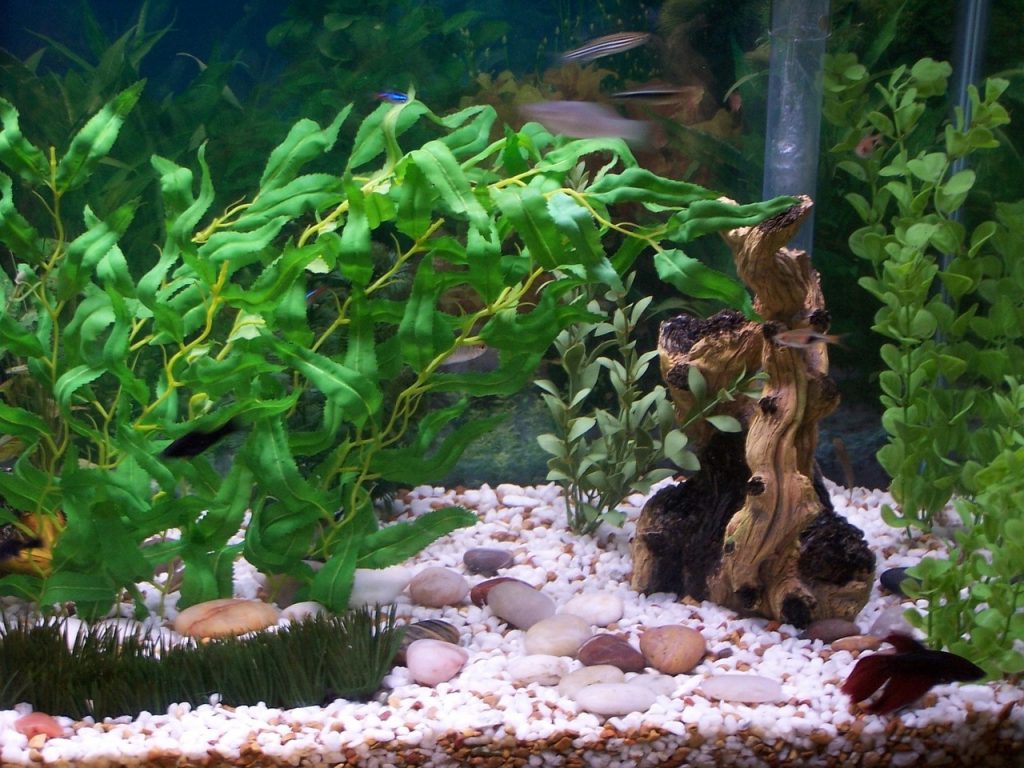
How To Clean Aquarium Gravel?
Believe it or not, cleaning aquarium gravel is a bit of a process. A lot of steps have to be taken to maintain the proper balance in the water so you don’t completely change the environment with every cleaning.
The most important thing to remember when cleaning gravel is this: you have to use some dirty water from the tank. Think about it like this. The tank is its own little ecosystem. There are a lot of things going on that keep everything in balance. Introducing the gravel to the tank after it’s been washed with new, clean water can be too much of a shock to the environment. Use a mix of half tank water, half clean water.
Put your fish in a bucket with tank water. Then, unplug the filter, lights, and any other electrical equipment. Drain the tank and put aside some of the dirty gravel. You do this for the same reason you mix clean and tank water when you clean. Bacterial colonies take time to grow and if you don’t set some aside, you’ll lose everything that was already working in your tank. The colonies that are living on the dirty gravel can grow and expand more quickly to recolonize the tank much faster than starting from scratch.
Next, put all the gravel in a bucket. You can use 2 if you have too much gravel. Don’t fill it up to the top, only go as high as ¾ of the way because you need room to move it around without it spilling out of the bucket. Then, use your sink, tub, or a garden hose to fill the bucket until the gravel is covered. Shake and stir the gravel in the water to get it clean. Don’t use soap as it could hurt your tank when you put the gravel back in.
Clean the sides of the tank and filter if needed. Then, put the gravel back into the tank, mixing the clean with the dirty. Fill the tank with tap water and add dechlorinating drops. You will often find this as water conditioner. Turn the filter, LED lights, etc back on. Don’t put the fish in right away, you have to wait until the temperature is right. That might mean waiting for it to return to room temperature or waiting for an aquarium heater to get it back to the right degree. Once the water is right, add your fish back in.
You can reduce the need for regular gravel cleaning by using an aquarium vacuum cleaner. This will remove the dirt and debris which gets trapped in the substrate and so will increase the time periods in between full gravel cleanings.
Conclusion
There are a lot of reasons why gravel is such an important addition to any aquarium. It not only looks good, it actually helps keep the tank healthy. By providing plants a place to root and bacteria a place to colonize, gravel serves an important purpose.
Another great thing about it is how much variety is available. You can find everything from neon gravel that glows under a blacklight to small pebbles that come from natural river rock to help you make the perfect home for your fish.
Our top pick for best aquarium gravel is Spectrastone Shallow Creek regular gravel. It’s one of the most natural looking gravels we found and provides your tank with just the surface it needs to thrive.
However, if you like a totally plain and uniform color, we’d probably plump for Seachem Flourite Black Clay Aquarium Gravel.
Seachem Flourite Black Clay Aquarium Gravel
